…continuing the Milestone Step 0
Some students go to college knowing exactly what they want to do. But most don’t. At large state universities it is not uncommon that over 75% percent of freshmen, even those who have declared a major, say they are uncertain about their major, and half will change their minds after they declare, sometimes more than once. That is one big reason that only 37% of students graduate in four years.
about their major, and half will change their minds after they declare, sometimes more than once. That is one big reason that only 37% of students graduate in four years.
Colleges and universities have vested interests in students declaring early. Retention rates for declared students are better, and they are more likely to graduate in four years. But college officials also recognize that deciding on a major can be overwhelming, especially when coupled with the fear that a wrong choice will result in added semesters and tuition. Students no longer have the luxury of stumbling into a major or making mistakes, not that they ever did.
This requires thinking ahead. Teenagers are not expected to know what to do with the rest of their lives at age 18, but with coaching they can cover the bases with prudent planning. Some majors have a curriculum that follows a tight sequence of courses. It’s easier to switch out of engineering than it is to take it up later in the college career.
The biggest mistake students make is failing to research what’s required of the major, and the profession. Nursing may sound attractive because a student wants to help people, but nursing students take the same demanding math and science curriculum as premed students, and the work is often technical and not for every kindhearted soul. It is also a similar track with Physical Therapy.
More niche filling additions to the list obviously reflect marketplace trends and student demand, like culinary science/culinology, digital arts and sports communication. At Montclair State University in New Jersey, which offers 300 majors, minors and concentrations, a new fashion studies major has been hugely popular, thanks to the university’s proximity to Manhattan; with Madison Square Garden and Giants Stadium in sight. It also guides the ambitious undergrad toward internship opportunities in a sports industry and event-planning major within its business school.
Still, it’s difficult to predict the employment market. That is why I will encourage students to think outside the  box. In other words if the job doesn’t exist…create one. Many students choose majors they think will lead to jobs, but four years from now freshmen will be applying for jobs that don’t even exist today.
box. In other words if the job doesn’t exist…create one. Many students choose majors they think will lead to jobs, but four years from now freshmen will be applying for jobs that don’t even exist today.
Most employers are looking for transferable skills the ability to problem solve, work collaboratively, write and speak clearly and think critically. These can be developed in any liberal arts discipline. It makes no sense to suffer through a major because you think it will lead to employment.
In the final analysis, wherever a teenager goes and does after high school, which I call Crossing the Gap: Preparing for the Transition, where they go does not matter as much as what they do when they got there.
The late great business philosopher, Jim Rohn, said this “A formal education will make you a living, but self-education will make you a fortune!” These two college graduates understood that. You can too! 1 (978) 820-1295
continuing our road trip… 0
Remember, this is a tour of extraordinary colleges; therefore different pedagogical methods may not be for you. That is okay, enjoy the trip, the ride will be educational. But for those students who fit the profile, the education one receives is rock solid (no pun intended).
 Now, let’s hop into our rented Nissan e-NV200 Electric van and head across New Hampshire to my favorite state of the Union, Vermont. Nestled up in the Northwest corner overlooking gorgeous Lake Champlain is Champlain College. The city of Burlington is the home of two other colleges. One is the most expensive public university in the country, U of Vermont and the other is St Michaels College.
Now, let’s hop into our rented Nissan e-NV200 Electric van and head across New Hampshire to my favorite state of the Union, Vermont. Nestled up in the Northwest corner overlooking gorgeous Lake Champlain is Champlain College. The city of Burlington is the home of two other colleges. One is the most expensive public university in the country, U of Vermont and the other is St Michaels College.
We are here to visit Champlain. Founded in 1878 it now has 2,396 happy to be here students. It has come into the 21st century with a strong endowment and financially prepared to offer innovative and pragmatic courses of study based on its’ “Upside-Down Curriculum” that are very much designed for the graduate to be highly employable in many fields upon graduation. In fact, 98% of them are employed in careers related to their majors  within two years.
within two years.
Watch the many videos that the communications majors have produced. Here are some students. As more than a few students will say, “You will work hard in your courses, but you will take away so much more than you ever expected. The professors will not let you slip through the cracks, and you will learn more about yourself and the world around you in even the most academic of classes.”
Now we have to take to the air and fly from Burlington to Charlotte, North Carolina. We then drive to High Point, North Carolina to a university, founded in 1924, that would never have been included on this list of extraordinary colleges before 2005.
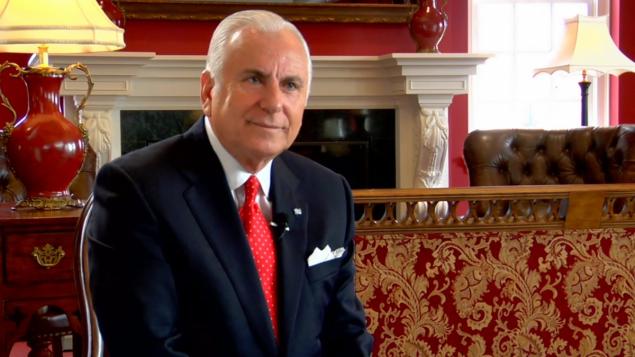 It was in 2005 that the High Point University trustees asked, encouraged, cajoled, begged and finally convinced Dr. Nido Quebin to become its President. What he has done in the last 10 years is incredible. Read and view the many interviews he has had since he took over. Took over are the wrong words. He has inspired faculty and students alike to be the best they can be. His style of positive leadership sparkles when he speaks. The focus is on the student and I marvel at his ability to bring all the academic departments together with a common mission.
It was in 2005 that the High Point University trustees asked, encouraged, cajoled, begged and finally convinced Dr. Nido Quebin to become its President. What he has done in the last 10 years is incredible. Read and view the many interviews he has had since he took over. Took over are the wrong words. He has inspired faculty and students alike to be the best they can be. His style of positive leadership sparkles when he speaks. The focus is on the student and I marvel at his ability to bring all the academic departments together with a common mission.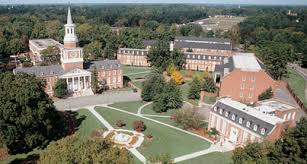
At this time, the school is not that well known outside of the Southeast, but that is about to change. It is definitely worth a strong look regardless of your prospective major there is something for everyone.
Of the many videos, be sure to set aside one hour to watch this one: ENTREPRENEURSHIP ROUNDTABLE DISCUSSION
Our next stop is Pennsylvania. We are going to visit Grove City College 60 miles north of Pittsburgh. This is a very competitive liberal arts college with particularly strong pre-medicine, engineering and business programs. So, what is so extraordinary about that? You ask.
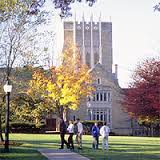 When parents ask me, “Why is college so expensive and why have costs, risen, on average, 2 to 3 times faster than inflation since the 1970’s?”, I point to Grove City College for the answer.
When parents ask me, “Why is college so expensive and why have costs, risen, on average, 2 to 3 times faster than inflation since the 1970’s?”, I point to Grove City College for the answer.
In 1972 the newly created Department of Education during the Carter administration, advocated for strong legislation that would make colleges, who wished to use any kind of Federal Aid in their financial aid packages, to meet complex gender equity requirements on their campuses. It was called Title IX. Over the years, the cost of complying with those rules has brought about ever increasing administrative costs.
Grove City keeping with its independent conservative principles cried foul! They did not want the education they provided to the undergrads be compromised by having to be encumbered with additional expenses that had nothing to do with education. Of over 4000 colleges, Grove City was the lone cry for sanity and critical thinking in the world of higher education.
However, they had to go all the way to the Supreme Court in 1984 to  maintain their independence from Federal control. The landmark case is truly one for the history books! Watch the video in its’ entirety above. They have since been able to keep costs under control. The COA in 2015/16 is less than $27,000/year. The college is debt free and self-funds programs to provide both need based and merit scholarships to those who qualify. They do all this without paying their professors any less than comparable colleges, having students sleep in bunk houses, eat canned tuna or limit its athletic programs to co-ed croquet and ultimate Frisbee competitions.
maintain their independence from Federal control. The landmark case is truly one for the history books! Watch the video in its’ entirety above. They have since been able to keep costs under control. The COA in 2015/16 is less than $27,000/year. The college is debt free and self-funds programs to provide both need based and merit scholarships to those who qualify. They do all this without paying their professors any less than comparable colleges, having students sleep in bunk houses, eat canned tuna or limit its athletic programs to co-ed croquet and ultimate Frisbee competitions.
Founded in 1876 it is a very traditional Presbyterian college and church attendance is required. But that may not be a bad thing. Do you agree?
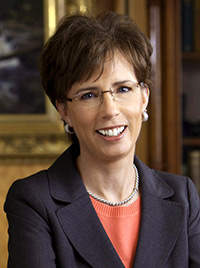 Whoops! What time is it? We better get to the airport, our flight leaves for San Francisco in two hours. The last college on our tour has made the list in large part because of its President, Dr. Pamela Eibeck, Ph.D. The University of the Pacific had been a very good medium size undergrad school for decades but when she took the helm at the same time her son became a college freshman at Santa Clara, refreshing changes rejuvenated the campus that, like many others, had become a bit stagnant. (Fun Fact: Read about why her son was disappointed his mom got the job.)
Whoops! What time is it? We better get to the airport, our flight leaves for San Francisco in two hours. The last college on our tour has made the list in large part because of its President, Dr. Pamela Eibeck, Ph.D. The University of the Pacific had been a very good medium size undergrad school for decades but when she took the helm at the same time her son became a college freshman at Santa Clara, refreshing changes rejuvenated the campus that, like many others, had become a bit stagnant. (Fun Fact: Read about why her son was disappointed his mom got the job.)
When I tell promising students in the Northeast about this college called the University of the Pacific their eyes light up! Wow, I have heard so much about the great surfing out there. I don’t tell them  right away that the Stockton campus is two hours drive to some of the best surfing anywhere in California, Santa Cruz. I want them first to think about why they are going to college for the academics, right?
right away that the Stockton campus is two hours drive to some of the best surfing anywhere in California, Santa Cruz. I want them first to think about why they are going to college for the academics, right?
 Speaking of academics, you will not be disappointed at UOP. Because Dr. Eibeck was Dean of Engineering at a Texas University before coming to UOP, that department is tops but her academic; analytic and leadership skills have strengthened all academic departments. Like Dr. Quebin of High Point University, she has inspired the entire faculty and student body to work as a team and do the best they can for themselves and for each other.
Speaking of academics, you will not be disappointed at UOP. Because Dr. Eibeck was Dean of Engineering at a Texas University before coming to UOP, that department is tops but her academic; analytic and leadership skills have strengthened all academic departments. Like Dr. Quebin of High Point University, she has inspired the entire faculty and student body to work as a team and do the best they can for themselves and for each other.
Thank you for traveling this far with me. By the way, please send me an email if you have an extraordinary college that deserves to be highlighted. I know there are more than the 15 I have discussed on this Blog. I will be including some Canadian and Universities around the globe in future installments. (By the way, what did you think of the European College in my second essay?) 🙂
If you have a high school student with college aspirations or simply needs some guidance even if college is NOT the next step, give me a call @ (978) 820-1295. Smart College Planning begins with a complimentary “get acquainted” 75′ conversation.
What! Me Worry? 0
Dear Class of 2022 and beyond,

 One of the most popular humor magazines, when I was in high school, was MAD magazine. Are you familiar with it? Staring out on each issue’s cover was the silly looking young man on the left. He was Alfred E. Neuman with his perpetual gaped tooth grin and his now universally known exclamation “What! me worry?” It was a timeless teenage sentiment. Can you identify with that? If you have completed your sophomore year, congratulations, you are now a high school junior ~ the largest; most competitive college-bound class in American history! Do not worry.
One of the most popular humor magazines, when I was in high school, was MAD magazine. Are you familiar with it? Staring out on each issue’s cover was the silly looking young man on the left. He was Alfred E. Neuman with his perpetual gaped tooth grin and his now universally known exclamation “What! me worry?” It was a timeless teenage sentiment. Can you identify with that? If you have completed your sophomore year, congratulations, you are now a high school junior ~ the largest; most competitive college-bound class in American history! Do not worry.
But do pay attention. You may now be in the same place I was way back when. Perhaps you are fifteen or sixteen years old with vague college aspirations? You may not have any specific reason to go to college other than it is the expected thing to do, and/or everyone else is doing it. Well, not everyone is planning on college and some of your classmates will probably not go to college. That is, not a four year liberal arts college. They may want to get technical training education or some sort of certification, however.
Crossing the Gap ~ Preparing for the Transition 0
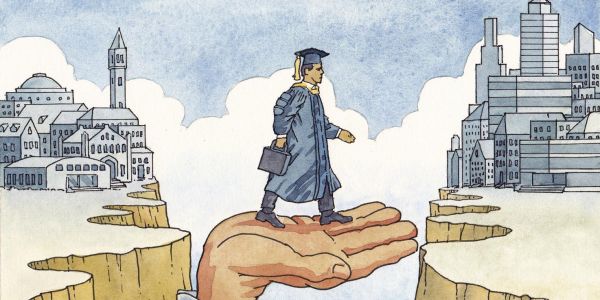 In the post WW II era of the early 50’s there were approximately 3 million college students; now there are 20 million. A college degree which used to be seen as a luxury, something which would, in a lifetime, enrich and enlighten….is now seen as a ticket to a bigger paycheck. Colleges, supported by the College Board and politicians in the District of Columbia, continue to say that a Bachelor degree is worth over 1.3 million dollars more in earnings than a high school diploma. Look at the report published by Georgetown University’s Center on Education and the Work Force.
In the post WW II era of the early 50’s there were approximately 3 million college students; now there are 20 million. A college degree which used to be seen as a luxury, something which would, in a lifetime, enrich and enlighten….is now seen as a ticket to a bigger paycheck. Colleges, supported by the College Board and politicians in the District of Columbia, continue to say that a Bachelor degree is worth over 1.3 million dollars more in earnings than a high school diploma. Look at the report published by Georgetown University’s Center on Education and the Work Force.
 But now we hear that the undergraduate degree is not enough and that an increasing number of graduates are unemployed or underemployed. If that is true, why is it true?
But now we hear that the undergraduate degree is not enough and that an increasing number of graduates are unemployed or underemployed. If that is true, why is it true?
- Are employers raising the proverbial bar for advancement or even entry level jobs within the organization?
- Is it because colleges are graduating students with little more knowledge or critical thinking skills than they had in high school ?
- Or is it because college graduates are not prepared to enter the work force because they have had little or no substantive work experience while they were college students?
Many would blame the “economy”. Yes, we hear a lot in the news about jobs being scarce because of the great recession. But we are not told why. I suggest it is because our Keynesian economic system, based on fiat currency and debt, has been subtlety used to manipulate trends of booms and busts in the economy since 1913 and was accelerated in 1971 when the dollar was taken off the gold standard. Currently, there is statistical evidence that the graduating college and high school class of 2013 continue to face dim job prospects. It is one of the symptoms of the excess borrowing and inflationary spending.
Despite that reality check, there is good news for the undergraduates here. 🙂
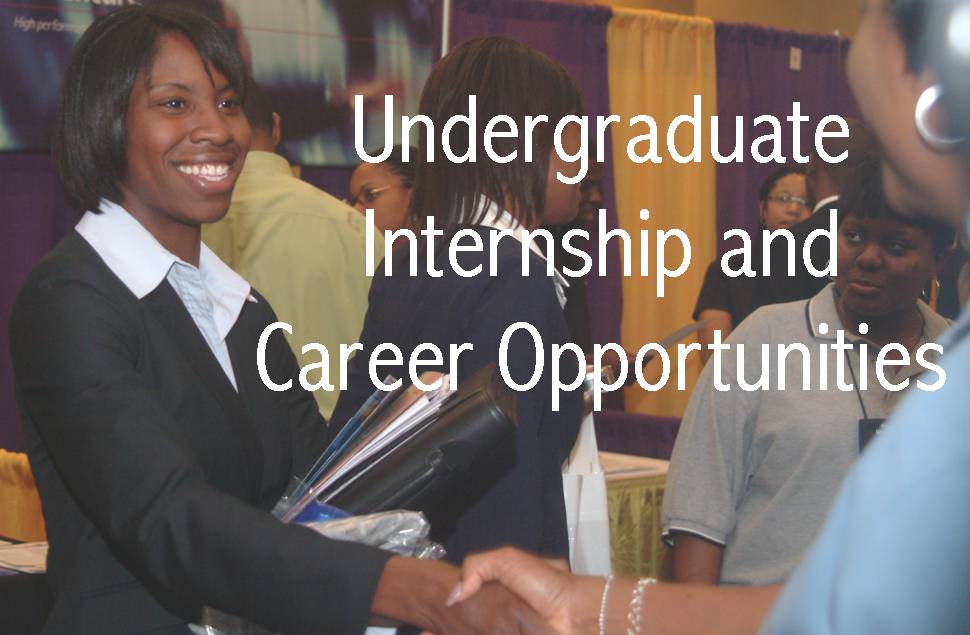 Newly minted college graduates (and parents) have made significant down payments on their futures in terms of both time and money, and they typically have a considerable burden of debt right out of the gate. If that graduate did not investigate the career services department beginning in the freshman year (preferably when they were still in high school) he or she may have missed getting the internship or co-op experience needed to optimize employment prospects.
Newly minted college graduates (and parents) have made significant down payments on their futures in terms of both time and money, and they typically have a considerable burden of debt right out of the gate. If that graduate did not investigate the career services department beginning in the freshman year (preferably when they were still in high school) he or she may have missed getting the internship or co-op experience needed to optimize employment prospects.
If you are an undergraduate now or thinking about going to college, look around your community. Is there something you see that is being done (legally) 🙂 by someone that not only looks interesting but enjoyable and …dare I say fun? Though you may not be able to tell at first, are they earning an income that supports their life style?
Take an honest assessment of your natural strengths and innate characteristics. (If you have done that work with me already, return to the computer where you have made it a favorite.) Research that work that looks like fun and learn what it will take to do it. By the way, did you know that the best definition of workis NOT in the dictionary? Here it is.
Work (wurk) n. ˜something you do when you would rather be doing something else”
Is that a Utopian ideal? Not necessarily.
If you are a whiz in math or science that does not mean you should be an engineer, mathematician or doctor. Your peers, relatives and teachers may say so, and they may be right. But I don’t have enough fingers and toes to count the number of adults I know who are now self-employed with time freedom to spend doing things they never dreamed they could do and spend time with their families all while writing their own paycheck. The work they are doing may even be unrelated to what their college major was. Learn from the learning curve of adults and college students like these who have walked the path ahead of you and changed their destinies by focusing on doing, not wishing.
If you cannot find your dream job why not create one! As a matter of fact, forget about a job for a moment. After all, did you know that JOB is an acronym for Just Over Broke. Jim Rohn, the late great business philosopher and mentor for millions of successful entrepreneurs said, “Formal education can help make you a living, but self-education will make you a fortune.”
He was a master with words and ‘walked the talk’ by doing. We ALL have the ability to change, but as Jim Rohn said in another memorable quote, “If you really want to do something, you will find a way; if you don’t you will find an excuse. If you would like some help or simply assurance that you are on the right track, give us a call. No more excuses. 🙂
Eric Goodhart ~ (978) 820-1295
Early College Decisions 0
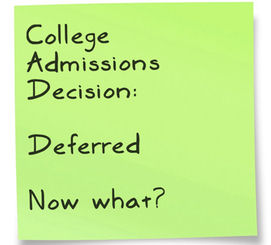 At the end of December, many students who applied to college Early Decision or Early Action are finding that they’ve been neither accepted nor rejected, but deferred. If you find yourself in this limbo, here are some guidelines for how to proceed.
At the end of December, many students who applied to college Early Decision or Early Action are finding that they’ve been neither accepted nor rejected, but deferred. If you find yourself in this limbo, here are some guidelines for how to proceed.
1. Don’t Panic ~ Most likely, if you’ve been deferred your credentials are in the ballpark for getting accepted. If they weren’t, you’d be rejected. However, your application wasn’t so far above average that the college wanted to give up a spot in the entering class until they could compare you to the full applicant pool. The percentages vary from college to college, but many students do get accepted after being deferred.
2. Find Out Why You Were Deferred ~ Unless the college asks you not to do so, give the admissions office a call and try to find out why you were deferred. Be polite and positive when making this call. Try to convey your enthusiasm for the college, and see if there were particular weaknesses in your application that you might be able to address. Some early applicants are deferred because they did not show enough interest in the college prior to submitting the application. Could this be you?
3. Update Your Information ~ Chances are the college will ask for your midyear grades. If you were deferred because of a marginal GPA, the college will want to see that your grades are on an upward trend. Also, think about other information that might be worth sending:
- New and improved SAT or ACT scores
- A new leadership position in a group or team
- A new honor or award
4 . Send a New Letter of Recommendation ~ Is there someone who knows you well who can really promote you effectively? If so, an additional letter of recommendation might be a good idea. However, make sure the college allows extra letters. Ideally, this letter should talk about the specific personal qualities that make you an ideal match for the particular college that has deferred you. A generic letter won’t be nearly as effective as a letter that explains why you are a good match for your first-choice college.
. Send a New Letter of Recommendation ~ Is there someone who knows you well who can really promote you effectively? If so, an additional letter of recommendation might be a good idea. However, make sure the college allows extra letters. Ideally, this letter should talk about the specific personal qualities that make you an ideal match for the particular college that has deferred you. A generic letter won’t be nearly as effective as a letter that explains why you are a good match for your first-choice college.
5. Send Supplemental Materials ~ Many applications, including the Common Application, provide the opportunity for sending in supplemental materials. You don’t want to overwhelm the admissions office, but you should feel free to send in writing or other materials that will show the full breadth of what you can contribute to the campus community.
6. Be Polite ~ As you try to get out of deferral limbo, you’re likely to correspond with the admissions office several times. Try to keep your frustration, disappointment and anger in check. Be polite. Be positive. Admissions officers are remarkably busy this time of year, and their time is limited. Thank them for any time they give you. Also, make sure your correspondence doesn’t become pesky or harassing.
7. Have a Back-Up ~ While many deferred students do get accepted during regular admissions, many do not. You should do all you can to get into your top choice school, but you should also be realistic. Make sure you have applied to a range of reach, match and safety colleges so that you will have other options should you get a rejection letter from your first choice.
If you have been deferred but have new information to present to the college, you’ll want to write a letter presenting the updates.
Searching for that Perfect College? 0
 The perfect college doesn’t exist. Almost any college, whether it’s an Ivy or a local community college, can be the foundation for productive and enjoyable college years. Every student’s experience has its ups and downs. Your parents may know what I mean. With colleges putting so much effort into diversification in recent years, few students fit the cookie-cutter images that proliferate in college view books.
The perfect college doesn’t exist. Almost any college, whether it’s an Ivy or a local community college, can be the foundation for productive and enjoyable college years. Every student’s experience has its ups and downs. Your parents may know what I mean. With colleges putting so much effort into diversification in recent years, few students fit the cookie-cutter images that proliferate in college view books.
Like with most things in life, college is what you make of it. If you are determined to study hard and find your social niche, you will probably be happy no matter what school you attend. However, that does not mean you can just throw darts at a map listing all colleges coast to coast. But it is always fun to put a pin on our office wall map when a student matriculates to a college he or she never knew existed until they went through the process I describe below. With hundreds of colleges to choose from, there will be some that fit better than others. But I have found that many students start the process without paying much attention to the purpose of going to college in the first place.
Fortunately, that can be easily rectified with some self-assessment by the student. In other words, you start the process with a careful look at yourself, not with a list of colleges. It is your own honest assessment of your academic profile, interests, learning style, and natural strengths that is central to finding a good fit college.
Most students start their lists, not only by listing well-known schools but the most competitive first. It is a faulty strategy. Before you start poring over view books and catalogs from colleges, you want to examine yourself as a person and as a student. Such an appraisal will yield data about yourself that will allow you to move forward with confidence.
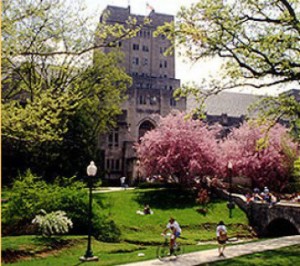
So, once that is all done you can consider other things, like location, total enrollment, male to female ratio, and athletics. Do you want a college within easy driving distance to home or across the country? Many students feel both callings at one time and another. Going to a college in the same state can still provide the independence and freedom students crave if they don’t commute. If you do not plan to be going home often, however, beware of the suitcase school, where the majority of students are locals who split the campus on the weekends.
The current health care concerns based on a “novel” strain of the common Coronavirus called Covid 19 has many people concerned about how far away from home to go college. However, if you are willing to go over 300 miles from home, your pool of prospective schools will grow significantly, not to mention chances of admission may be enhanced as well. That is, if you show some genuine measure of demonstrated interest.
By the way, do NOT dismiss a college without doing your AAA due diligence simply because it has fewer students than your high school. In college, you will likely have peers from all over the country and many countries, unlike your little community of students whom you have known most of your life. It is a big world and your journey has just begun. No better place to do it than within a community where you can learn from both professors as well as fellow undergrads that come from different parts of the globe. Each of you can share ideas and experiences that will be mutually beneficial.
Key Steps to Success 0
 A college education has long been viewed as a ticket to a better quality of life. Though it is truly a milestone decision in a young person’s life it does not necessarily mean that a particular college decision will have the highest rate of return in achieving life goals. Unfortunately, some students do not think clearly about this decision, buying the brand name college and taking on large amounts of debt.
A college education has long been viewed as a ticket to a better quality of life. Though it is truly a milestone decision in a young person’s life it does not necessarily mean that a particular college decision will have the highest rate of return in achieving life goals. Unfortunately, some students do not think clearly about this decision, buying the brand name college and taking on large amounts of debt.
For students who don’t want to have daunting repayment obligations, without a solid income opportunity consider this:
- Know the average amount of debt that students carry at each of your potential colleges. Check out college-insight.org for such information.
- Complete a money-saving Dry Run before you even have a final list of colleges in mind.
- Discuss with counselors and advisors what majors to consider and understand how your natural strengths and innate characteristics fit related careers.
- Earn and save money during college. Many bright students are earning over $1000/month part-time while in college without sacrificing their academic responsibilities. Call Eric and he will show you how they are doing it.
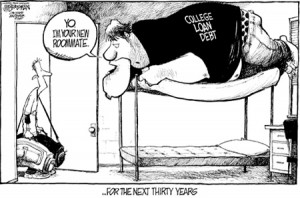
“Excessive student debt, often made without an explicit decision on its impact on future life choices, not only restricts traditional career choices but the basic ability of young people to take risks requiring them to defer their dreams,” says Robert Shireman, executive director for the nonprofit Project on Student Debt.
According to the Project on Student Debt, the average 2010 graduate carried $25,250 in loans. (Not to mention what the parents have borrowed.) The big galoot above says to the young graduate, “Yo! I am your new roommate…for the next thirty years.”
Astrid Neilson, a 23-year-old who graduated from the University of Virginia, assumed a huge financial burden to attend a public university as an out-of-state student. Her life is definitely impacted by the $90,000 college debt from the college. (Some were signature loans from a relative.) I really want to go to law school, but can’t unless I get a scholarship. Possible, but not likely.
Neilson did not consider future income before assuming her loans, although she anticipated always working in the nonprofit or public sector. Her choices confirm a recent survey by student-loan provider Sallie Mae that post-graduate income was not a factor for an incredible 70 % of students and parents in determining how much to borrow to finance a college degree. (Can you say Dry Run?)
 So after the glossy college brochures arrive in the mail and the visits to leafy college campuses are over, students need to ask themselves: Can I afford this school without excessive borrowing? If money saved falls short, consider living at home for two years, get the necessary pre-requisites out of the way at a community college and transfer to your state or private university. Be smart now and financially independent later.
So after the glossy college brochures arrive in the mail and the visits to leafy college campuses are over, students need to ask themselves: Can I afford this school without excessive borrowing? If money saved falls short, consider living at home for two years, get the necessary pre-requisites out of the way at a community college and transfer to your state or private university. Be smart now and financially independent later.
Do not like that option? Then you should read The Millionaire Next Door.
Your College Essay aka “Personal Statement” 0
 Yes, your college application essay is your personal statement. It is an opportunity to express your viewpoints, to be creative, to demonstrate your writing ability, and to distinguish your application from the many others that the Admission Officer will read.
Yes, your college application essay is your personal statement. It is an opportunity to express your viewpoints, to be creative, to demonstrate your writing ability, and to distinguish your application from the many others that the Admission Officer will read.
Your essay can provide the Admission Officer with insight into at least three of your personal qualities:
1) How well you think
2) How well you write, and
3) Who you are
Famous Pulitzer Prize winner sportswriter, Red Smith, once said: “Writing is easy. Just sit and look at a blank sheet of paper until blood starts dripping from your forehead.” 🙂 Yes, even writers who are paid handsomely, have a tough to time to place words on paper in the beginning. So, do not be fearful or intimidated by the task. Your college essay is an important part of your application. An outstanding essay can have a positive influence on the decision. Likewise, a poorly-written, hastily done or sloppy essay can have a negative influence on the admission decision. It is worth your time to produce your best work.
Without a doubt, high school students fear writing the personal essay more than anything else, especially those who are not “writers.” It doesn’t have to be that way, if you follow some proven techniques for organizing your thoughts, writing, editing and typing.
Want tips on how to start your essay? Watch this Webinar. Even though you may not be applying to a University of California school, the tips on writing a “personal statement” will be helpful.
Quite possibly the most important thing to keep in mind is that you should be expressing yourself – who you are and what you believe in. Your goal is to make the admissions staff notice you…and to show them what you’re all about…and why they should accept you.
There are no right and wrong ways to write essays – only what is right for you. Since you may have different essays to write for different colleges, the first part of this section are specific hints, do’s, don’t, tips, suggestions and techniques.
Just How Important Is the Essay? . . . VERY!
Sometimes, in the hoopla about SAT and ACT test scores, class rank, AP courses and GPA, the weight of the personal statement/essay is overlooked. Most admissions counselors will tell you that the essay ranks right up there as an important piece of the puzzle, and can often be the final deciding factor between candidates who are otherwise equally qualified.
To show you the relative importance of the essay, here are a couple of paraphrased comments about the essay made by guidance counselors and college admissions:
*The better the college or university, the greater the importance of the essay, and the more it contributes to the final determination.
* At a very large university receiving over 15,000 applications per year, every
essay is read.
* College admissions staffs use the essay to get to know the student more personally to go beyond what the numbers show.
* Many admissions staff views the application as a “flat” document, but they view the essay as a third dimension, to bring life to the application.
Just What Are They Looking For?
On a very broad plane, the admissions staff is looking for these characteristics in your essay – regardless of the topic – they want to see your ability to: Read more »
Five MORE Extraordinary Colleges 0
In our March newsletter I wrote about five extraordinary colleges that you never heard of, but should. I am not sure if my putting the spotlight on them increased their application count, probably not, but here are five MORE extraordinary colleges in a periodic series we plan, to expand the vision of the college bound, beyond the usual suspects. I look forward to your thoughts on these and other colleges you may feel need more recognition.
Of course, when all is said and done, does it matter that much where one goes to college? If you are not looking for a specific technical training only offered at a particular college, I say, not necessarily. What really matters is what you do when you get there.
Once in a while I like to step back and look at the colleges that have something to offer that make them stand out. It does not mean they are right for you. But one or more of them could be.
Three of these colleges are definitely not ones that would come up in casual conversation at the dinner table or the country club. Come with me now and enjoy the tour.
 # 1. In the beautiful Pacific Northwest just 35 miles from Seattle sits the University of Puget Sound. Founded in 1888, it is a highly selective liberal arts college with close to 3,000 undergraduates. Because of the Graduate programs in the health sciences and education it is a University. However, the emphasis and Mission Statement is focused on the undergraduate. It offers over 40 majors and 1,200 courses taught by a strong faculty that comes from all over North America.
# 1. In the beautiful Pacific Northwest just 35 miles from Seattle sits the University of Puget Sound. Founded in 1888, it is a highly selective liberal arts college with close to 3,000 undergraduates. Because of the Graduate programs in the health sciences and education it is a University. However, the emphasis and Mission Statement is focused on the undergraduate. It offers over 40 majors and 1,200 courses taught by a strong faculty that comes from all over North America.
Because of its gorgeous location and living conditions, it attracts educators to Puget Sound. For that reason, the University is in the enviable position to be able to hire only the most qualified faculty applicants. The result is a fine Liberal Arts program in addition to rich programs in Asian Languages and Culture, English/creative writing, Communication/Journalism, Music, International Business and the Sciences. They are all impressively strong.
Students describe the academic experience this way. “The professors challenge their students and hold high expectations of them. Writing is stressed across all disciplines at UPS, and students can expect to do a lot of it.” All classes, including labs, are taught by professors and, what I like, all freshman students are assigned a professor from one of their classes to serve as an advisor for their entire first year.
So, if you are a lover of the great outdoors and you want to be challenged academically, Puget Sound is a beautiful place to spend four years many students say.
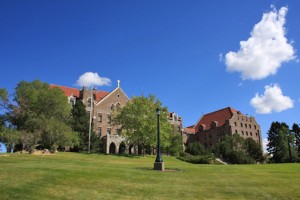 # 2. Now let us travel east across the Rockies to Montana. In the capitol, Helena, you will find one of the most successful (in terms of student outcomes) liberal arts and pre-professional colleges in the west. Founded in 1909 by Catholic Missionaries, Carroll College offers strong programs in the core liberal arts plus eight pre-professional programs, including law, medicine, veterinary science, pharmacy and dentistry.
# 2. Now let us travel east across the Rockies to Montana. In the capitol, Helena, you will find one of the most successful (in terms of student outcomes) liberal arts and pre-professional colleges in the west. Founded in 1909 by Catholic Missionaries, Carroll College offers strong programs in the core liberal arts plus eight pre-professional programs, including law, medicine, veterinary science, pharmacy and dentistry.
Is a city too crowded for you? Do you want solid pragmatic programs in business, accounting or Engineering, among others, at a college that gives you more space to breathe? Well, contact one of Carroll College’s bright and enthusiastic regional counselors here. There is much to see and learn.
This college came to my attention several years ago as one of the hidden gems of higher education by a colleague. Although 40% of students are from outside of Big Sky country, it is not as well known as other gems like Allegheny, Elon, Kenyon and Beloit colleges.
But definitely worth your consideration.
The tour continues here…
Standardized Test Redux 0
March 21, 2010
Colleges Explore Shades of Gray in Making Entrance Tests Optional
Ursinus College considered fairness and ideals as well as marketing and logistics
Sarah Bones for The Chronicle
 Last year Richard DiFeliciantonio (right), vice president for enrollment at Ursinus College, hired a new admissions director, Richard Floyd, whose questions about the role of test scores prompted Ursinus to reconsider its stance.
Last year Richard DiFeliciantonio (right), vice president for enrollment at Ursinus College, hired a new admissions director, Richard Floyd, whose questions about the role of test scores prompted Ursinus to reconsider its stance.
By Eric Hoover
When a college stops requiring standardized admissions tests, no rainbow magically appears. Its endowment doesn’t grow, and its costs don’t shrink. Presidents still worry, professors still complain, and students still drink too much on Saturday nights.
Nonetheless, tales of going “test optional” often have a romantic tinge. In them, admissions deans, worried about equity and anxious teenagers, finally decide to do the right thing by casting off those terrible tests. After that, everything on the campus gets better.
Like many stories, this one invites other interpretations. A popular reading is that competition alone compels colleges to drop their ACT and SAT requirements. In this rendering, colleges care more about their image than anything else.
Fifteen years ago, colleges could still expect to make waves when they adopted test-optional policies. Over the last decade, however, dozens of private liberal-arts colleges have nixed their testing requirements, and these days the announcements cause more of a shrug than a splash.
Nonetheless, the choice remains controversial, often cast as either a noble move or a deceptive one.
In fact, the decision typically melds various motives, arising from a place where marketing and mission overlap. Data often drive a change of heart, but numbers alone don’t always explain whyor when a college alters its testing policy. Often the switch happens gradually, following prolonged discussions, a change in leadership, or some other institutional shift. Like most issues in admissions, the decision is often more complicated than it might seem.
